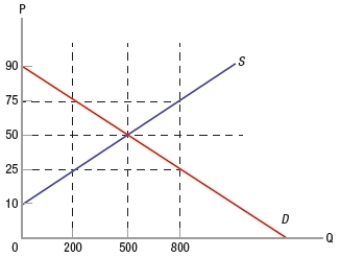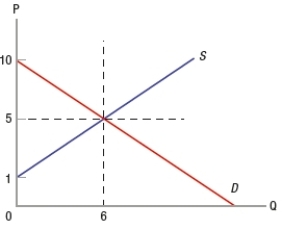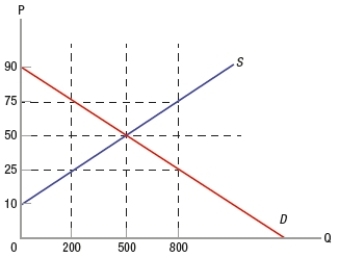Correct Answer

verified
Correct Answer
verified
Multiple Choice
Suppose that a customer's willingness-to-pay for a product is $120, and the seller's willingness-to-sell is $110. If the negotiated price is $119, how much is consumer surplus?
A) $1
B) $9
C) $10
D) $20
Correct Answer

verified
Correct Answer
verified
True/False
The French term for "let it be" is ceteris paribus.
Correct Answer

verified
Correct Answer
verified
Multiple Choice
Suppose that a customer's willingness-to-pay for a product is $5, and the seller's willingness-to-sell is $4. If the negotiated price is $3, how much is consumer surplus?
A) $1
B) $2
C) $5
D) $8
Correct Answer

verified
Correct Answer
verified
True/False
At times, there are conflicts between market outcomes that are efficient and outcomes that society deems fair.
Correct Answer

verified
Correct Answer
verified
True/False
The gap between the demand curve and the market price is called deadweight loss.
Correct Answer

verified
Correct Answer
verified
Multiple Choice
A price floor is binding when it
A) keeps the price lower than it would be in a free market.
B) causes the price to be higher than it would be in a free market.
C) leads to greater competition in a market.
D) reduces costs to lead to lower free-market prices.
Correct Answer

verified
Correct Answer
verified
True/False
If consumer surplus is $6 million and producer surplus is $4 million, then we know that deadweight loss is $2 million.
Correct Answer

verified
Correct Answer
verified
True/False
A price ceiling usually results in a surplus and a misallocation of resources.
Correct Answer

verified
Correct Answer
verified
Multiple Choice
An effective price ceiling results in
A) a surplus.
B) equilibrium in the market.
C) quantity supplied exceeding quantity demanded.
D) a shortage.
Correct Answer

verified
Correct Answer
verified
Multiple Choice
If there is only one provider of electricity in a city, that market is likely to fail due to
A) public ownership of resources.
B) external benefits.
C) lack of competition.
D) asymmetric information.
Correct Answer

verified
Correct Answer
verified
Multiple Choice
(Figure: Understanding Price Ceilings and Floors) In the graph, which price would allow for a binding price ceiling? 
A) $25
B) $50
C) $75
D) $90
Correct Answer

verified
Correct Answer
verified
True/False
If total surplus equals $45,000 at the equilibrium price, then total surplus will rise if the price falls below equilibrium.
Correct Answer

verified
Correct Answer
verified
True/False
Suppose that a customer's willingness-to-pay for a product is $5, and the seller's willingness-to-sell is $2. If the negotiated price is $3, producer surplus is greater than consumer surplus.
Correct Answer

verified
Correct Answer
verified
True/False
If tariffs on lumber from Canada increase construction costs, producer surplus for new homes increases.
Correct Answer

verified
Correct Answer
verified
Multiple Choice
In the market for medicine, if surplus is transferred from producers to consumers, from the standpoint of efficiency
A) the current price of medicine is too high.
B) the current quantity of medicine is too low.
C) deadweight loss could be reduced if the current price were lower.
D) total surplus increased because consumers paid lower prices for the existing inventory.
Correct Answer

verified
Correct Answer
verified
True/False
(Figure: Determining Surplus 2) In the graph, consumer surplus is $15. 
Correct Answer

verified
Correct Answer
verified
Multiple Choice
Markets tend to produce
A) the right amount of a good exhibiting external costs.
B) the right amount of a good exhibiting external benefits.
C) too little of a good exhibiting external costs.
D) too little of a good exhibiting external benefits.
Correct Answer

verified
Correct Answer
verified
True/False
Nonrivalry means that once a good is provided, others cannot be excluded from enjoying it.
Correct Answer

verified
Correct Answer
verified
True/False
(Figure: Understanding Price Ceilings and Floors) In the graph, a maximum price of $75 would allow for a binding price ceiling. 
Correct Answer

verified
Correct Answer
verified
Showing 301 - 320 of 343
Related Exams